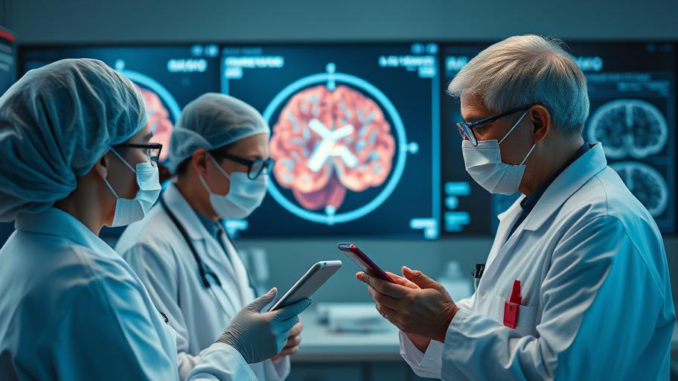
Summary
Scientists have repurposed an ALS drug into a groundbreaking imaging probe. This new tool allows for early detection of oxidative stress, a key factor in neurodegenerative diseases like Alzheimer’s and ALS. This advancement offers hope for earlier diagnosis and more effective treatment.
Secure patient data with ease. See how TrueNAS offers self-healing data protection.
** Main Story**
Repurposed ALS Drug Illuminates Neurodegeneration: A Game Changer?
Exciting news in medical imaging, folks! There’s a potential breakthrough that could change how we approach neurodegenerative diseases like Alzheimer’s and ALS. Scientists have cleverly taken edaravone, a drug already used for ALS, and turned it into a powerful imaging tool.
The Early Detection Dilemma
The real issue with neurodegenerative diseases is that they’re often only caught after symptoms become obvious. And, let’s be honest, at that point, treatments aren’t always as effective as we’d like. Being able to spot these diseases early has always been a huge challenge.
Traditional methods? They mostly rely on seeing physical symptoms or using CT scans or MRIs to rule out other things, but they often miss the early, subtle signs of trouble. It can be a frustrating process. You’re left thinking, surely there’s a better way, right?
A New Way to See Inside the Brain
That’s where this repurposed drug comes in. They’ve transformed edaravone into a PET imaging probe called [18F]fluoroedaravone ([18F]FEDV), and it could be a total game-changer. Now, edaravone itself is an antioxidant. It works by cleaning up those pesky reactive oxygen and nitrogen species (RONS) in your body.
And look, RONS aren’t all bad. They’re actually needed for normal cell function, but too much of them leads to oxidative stress. Think of it like this: a little bit of spice can make a dish amazing, but too much ruins it. So, this oxidative stress? It causes tissue damage, especially in the brain, and that accelerates neurodegenerative diseases.
Clever researchers at St. Jude and the University of Virginia realized edaravone’s potential. They radiolabeled it, creating [18F]FEDV. This makes it detectable by PET scans. Basically, when you administer [18F]FEDV, it emits positrons. These light up the areas where the drug accumulates, showing where there’s a buildup of RONS and oxidative stress. Imagine being able to directly measure oxidative stress levels – something we couldn’t do non-invasively before. That’s a pretty big deal.
Why This is Different?
Why is this such big news? Well, let’s break it down:
-
Direct Oxidative Stress Measurement: Unlike other PET tracers that look for inflammation or amyloid, this one goes straight to the source: oxidative stress.
-
Tracking Over Time: This allows us to monitor RONS activity in real-time. That means we can track how a disease is progressing and see if antioxidant treatments are actually working. Which, let’s be real, is incredibly important.
-
Potential for Early Detection: By finding oxidative stress before major symptoms hit, we can potentially diagnose and intervene earlier, maybe even slow down the disease.
-
Versatile Biomarker: [18F]FEDV reacts with different types of RONS, making it useful for many neurodegenerative conditions.
Clinical Trials and What’s Next
The next hurdle? Clinical trials, of course. We need to make sure [18F]FEDV is safe and effective in people with ALS, Alzheimer’s, and other similar conditions. But also, researchers are trying to tweak the PET imaging so it can detect oxidative stress in the brain even more accurately.
Look, if this works, it could change everything. We could use [18F]FEDV to pick the right patients for antioxidant treatments, keep a close eye on how they’re responding to the treatment, and maybe even predict when someone will start showing symptoms. It’s a serious glimmer of hope for diseases that are currently incurable. It’s really impressive what can happen when you think outside the box and repurpose existing drugs to tackle tough medical problems.
I remember reading a similar story a while back about researchers using a drug initially developed for heart conditions to potentially treat a rare form of childhood blindness. The innovation and the potential for real human impact are genuinely inspiring.
Anyway, I’m eager to see what the future holds for [18F]FEDV. It could seriously change the game in how we diagnose and treat neurodegenerative diseases.


So, now we can *see* the oxidative stress, does that mean we can finally prove my uncle’s ‘antioxidant smoothie’ obsession wasn’t completely bonkers? Asking for, uh, myself.
That’s a great question! While the probe helps us *see* oxidative stress, proving the efficacy of antioxidant smoothies is a bit more complex. We still need clinical trials to determine the impact of dietary antioxidants on brain health. Maybe your uncle was ahead of his time! What ingredients did he use?
Editor: MedTechNews.Uk
Thank you to our Sponsor Esdebe